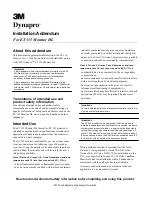
INDCO, Inc.
M-M-30118 mixer manual HS-5
date: 3/8/05
General
The HS-5 series 5-horsepower electric powered high-speed
dispersers are designed for small production batches.
Each model comes complete with following features:
• Variable speed:
- Mechanical belt drive: 600 to 4000 RPM.
- Electronic inverter drive: 180 to 3600 RPM.
• Impeller shaft: 1.25” dia. - 316 stainless steel.
• 6” design ‘A’ disperser blade - 304 stainless steel.
• Pneumatic cylinder lift mechanism, 36” travel range.
• Container holder with capacity for 55-gallon drum.
• TEFC or Explosion-Proof electric motor.
• Optional tachometer.
Installation
Receiving:
Before removing any packing, visually inspect the exterior
of the shipment for any sign of damage. Should there be
any damage, bring it to the attention of the delivering UPS
or truck line and note the same on the receiving ticket.
Should there be damage you must place a claim with the
truck line. They are the only ones who will pay for the
damage done and you are the only one who can place that
claim.
Mounting:
Ensure the unit is securely bolted to your floor and is level,
square, and plumb. Leave space around the unit for
cleaning, inspection and maintenance.
Pre-Start Up Check List:
1. Are all mounting bolts tight?
2. Is disperser blade mounting bolt tight?
3. Has electric motor been wired according to the diagram
on the motor label? Is motor grounded?
4. Does motor have emergency stop located as per local
code?
5. Bump motor and check rotation, looking down into the
container, shaft should rotate clock-wise. If direction is
incorrect reverse motor as explained on the motor label.
Safety
Please follow the below safety precautions. Read this
complete manual before trying to operate your mixer.
Failure to follow these instructions could result in serious
bodily injury or death.
• Never move the unit without a suitable lifting device.
• Have a qualified individual bring power to your unit.
• Always ground the unit.
• Never run the unit in open air.
• Never adjust the speed without the unit running.
• Always lockout the power when working on the unit.
• Always use the container holder to restrain the container
during operation.
Electric Motor Safety:
Motors should be installed, protected and fused in
accordance with latest issue of National Electrical Code,
NEMA Standard Publication No. MG 2 and local codes.
Eyebolts or lifting lugs are intended for lifting the motor
only. These lifting provisions should never be used when
lifting or handling the motor with other equipment (i.e.
gearboxes or other driven equipment) as a single unit. Be
sure eyebolt is fully threaded and tight in its mounting hole.
Eyebolt lifting capacity rating is based on a lifting alignment
coincident with the eyebolt center-line.
Eyebolt capacity decreases as deviation from this alignment
increases. See NEMA MG 2.
Frames and accessories of motors should be grounded in
accordance with National Electrical Code (NEC) Article 430.
For general information on grounding refer to NEC Article
250.
Rotating parts such as pulleys, couplings, external fans,
unusual shaft extensions should be permanently guarded.
Keep hands and clothing away from moving parts. Trained,
qualified personnel should make electrical repairs only.
Mechanical Variable Speed Drive Safety:
When maintenance is required in the area of the equipment
necessitating removal of the guarding, the prime mover
should be turned off and “locked out”.
The user of variable speed belt drives should be aware of
the hazards through misuse of the product or failure to
protect against contact with moving parts.
Spring-loaded pulleys should never be disassembled without
first receiving instruction from factory.
Rapid acceleration or braking, or shock loading may cause
a shaft to fracture due to torsional twist beyond its capacity.
All mounting screws on the pulleys must be kept tight.
Even though each pulley is individually balanced at the
factory the system in which the pulleys operate may
resonate, particularly at high RPM’s over 1800. Sometimes
a new belt will reduce vibration levels in a system.
page 3 of 11





























